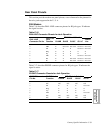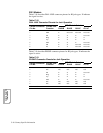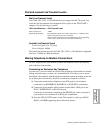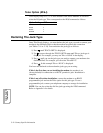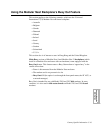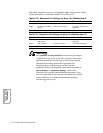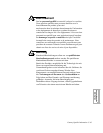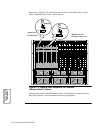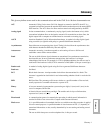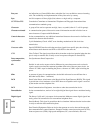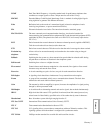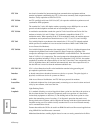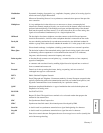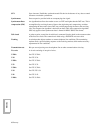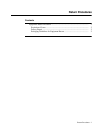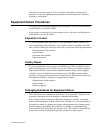
Glossary-1
Glossary
Glossary
This glossary defines terms used in data communications and in the 326X Series Modem documentation set.
ACU Automatic Calling Unit or Auto-Call Unit. Internal or external to the DCE, the ACU is a
command set interface between the attached DTE and the modem that uses the normal DTE/
DCE interface. The ACU allows for direct modem control and configuration by the DTE.
Analog signal In data communications, a continuously varying signal (such as the human voice), which
conventional telephone lines are designed to transmit. For transmission on these lines, the
digital output from a computer or terminal must be converted to an analog signal.
ASCII American Standard Code for Information Interchange. A method of coding digital signals
using seven bits (or eight bits with parity) to generate 96 different characters.
Asynchronous Data without an accompanying time signal. Timing is derived from the asynchronous data
with character boundaries defined by start and stop bits.
Auto-answer Automatic answering. A modem responds to an incoming call over a dial line and
establishes contact with a remote modem.
Baud The rate at which discrete signal elements are transmitted. In asynchronous transmission,
baud rate=bit rate. In most synchronous transmissions, the baud rate is an integer
submultiple of the bit rate. For example, in V.22 bis QAM modulation, four bits are sent in
each baud. If the baud rate is 600, V.22 bis transmits at 2400 (600 x 4) bits per second (bps).
Baudot code A method of coding digital signals using five bits to generate 58 different characters.
Baud rate See Baud.
BCC Block check character. A unique number derived from data transmitted in a block. The
character is appended to data blocks for use in determining whether a block is received with
errors.
BER Bit Error Rate. The percentage of bit errors relative to a specific number of bits received;
usually expressed as a number referenced to a power of 10.
Binary A base two numerical representation system using two digits, 0 (zero) and 1 (one); in the
case of a computer, Off and On.
Bit A blend of the two words bi
nary and digit. The smallest unit in a byte of information,
expressed as 0 (zero) or 1 (one).
Bit-oriented A communications protocol or transmission procedure in which control information is
encoded in fields of one or more bits. Compare with Character-Oriented.
Block error (1) A specified number of transmitted data bits over which an encoding procedure is applied
for error-control purposes. A specified number of data characters or bits. (2 ) Aquantity of
transmitted information, or data, usually determined by its own starting and ending control
characters.
bps The rate at which data passes over the telephone line, in bits per second.



